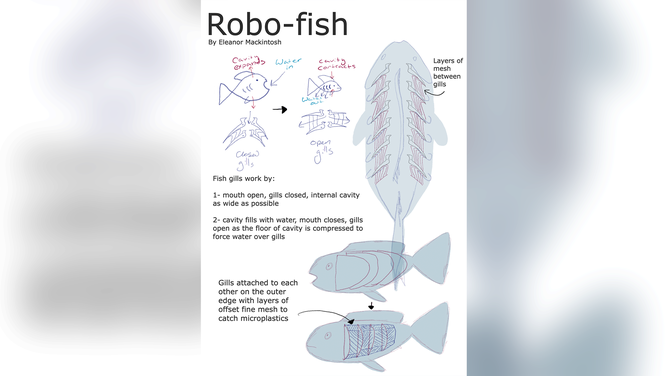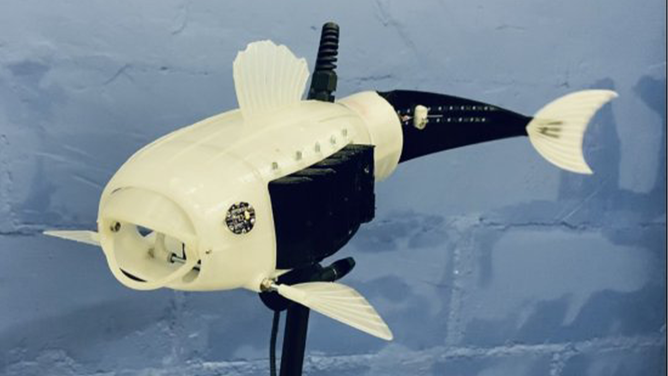Meet Gilbert: The robotic fish designed to help clean plastic from our waterways
This was the first year the University of Surrey held the Natural Robotics Competition, and nearly 100 submissions were received from people around the world.
GUILDFORD, England – A plastic-eating robot fish has been chosen as the winner of the University of Surrey's public robotics competition that allowed people to come up with a design for a robot inspired by animals that would benefit the world and the environment.
This was the first year the university held the Natural Robotics Contest, and nearly 100 submissions were received from people interested in nature and robotics for a chance to see their design turned into a real engineering system.
Dr. Robert Siddall, originally from California but grew up in the United Kingdom, teaches aerospace engineering with a focus on robotics at the University of Surrey.
He said there were quite a number of interesting designs that were submitted from people around the world with the hopes of being turned into a working robot.
Some of those designs included a forest-protecting robot bird and a robotic sea urchin.
"We chose Eleanor's both because we really liked the idea and the way it used bioinspiration, but also because cleaning up ocean plastic was the most common purpose among all the entries we received, so we thought our winner should reflect that," Siddall told FOX Weather.
The winning design: Gilbert the robo-fish

Eleanor Mackintosh is from West Sussex, England, and is in her final year at the University of Surrey and is studying chemistry. She came up with the winning design.
(Eleanor Mackintosh/The University of Surrey)
"It's well known that we have a problem with plastics in the environment," said University of Surrey chemistry student Eleanor Mackintosh. "We face the challenges of figuring out ways to reduce and prevent it as well as clean up the water that's already out there."
Mackintosh came up with the winning design chosen by a panel of international judges.
She said she wanted her design to reflect the efforts to rid the world's water of plastic.
"I decided to base the design on a fish and focus on the properties of gills specifically since fish use their gills to filter oxygen into their blood," she said.
So, she said she used that and adapted that ability as a filter for microplastics.
FLORIDA COMPANY PROVIDES UNIQUE, ECO-FRIENDLY WAY TO KEEP MARINE LIFE ALIVE AFTER YOU DIE
"I tried to design it in such a way that it worked much like fish gills work," she said. "With the mouth open and gills closed, water and particles fill the cavity within the fish's body. After that, the mouth shuts, the gills open, and the cavity is compressed to force the water out of the gills and through the mesh filter, which will trap microplastics within the body of the fish."
This wasn't her first design, however.
Mackintosh told FOX Weather she initially had a design in mind based on a plant but found the Robo-fish could be developed a bit more.
"So, I decided to refine that concept instead," she said. "At that point, there were only a couple of iterations of the design before I was happy with the final version."
From idea to reality
After the winning design was chosen, work began turning the idea into a working robot.
"We took some time and discussed our approach to building it and then got straight to designing,' Siddall said. "Our rule for ourselves was that it had to only use components and manufacturing that everyone could access, which is why the entire robot is 3D printed."
It wasn't an easy journey, however.
"We went through a couple of prototypes," Siddall said. "The first version of the fish sprung a leak, and we destroyed all the electronics. In the end, it took about a month to design and build."
Eventually, the robot was built and tested, and the hope is to continue to refine the design.
GROUNDBREAKING RESEARCH SHOWS GREAT WHITE SHARKS MAY CHANGE COLOR TO BETTER HUNT THEIR PREY
"I already have a few students working on robotic boats for sampling water health, so the fish will be added to our fleet,' Siddall said. "Our plan is to make a base station that the fish can dock with to deliver samples and recharge. It has the sensors onboard needed for autonomy, but we need to write a lot more code to make it swim on its own."
So, for now, Gilbert is tethered to a power source. But with continued advancement in the design, it could be an excellent way to clear microplastics from the world's waterways.
So far, Gilbert is only being used in small lakes and streams.
"We emphasized small lakes and streams mainly because that's where there is a real lack of data compared to the oceans," Siddall said. "The fish could happily swim in the ocean, although it's only plastic, so it couldn't go especially deep."
Right now, anyone with a 3D printer can build their own Gilbert and use it locally, and Siddall said there would be a more sophisticated version soon.
"I'm only working with other researchers at the moment, but I'm talking to wildlife and nature trusts to do some pilot robot missions in the near future," Siddall said.





